With hesitation, I entered the small yoga studio in Oakland, nearly every inch of my body sore from a punishing trail race.
I don’t do yoga—I’m just not that into it. It’s so damn slow.
But then our instructor, Caitlin Smith, began the class, which was full of inflexible trail runners with black toenails. Pretty soon she had us downward-dogging our way through poses that made muscles alternately slacken and tremble.
Caitlin’s lithe, precise moves and flexibility belied the fact she won a trail 50K just a couple of days earlier in a blazing time of 3:57. She clearly wasn’t afflicted with that thing called Delayed Onset Muscle Soreness, which makes most runners feel their worst two to three days after an endurance event.
I recall when Caitlin came seemingly out of nowhere and started to dominate Bay Area races in early 2009. She excelled at both road (winner of the Nike Women’s Marathon) and trail (winner of the North Face 50-mile Endurance Challenge). When I placed 4th at the Ohlone 50K, I was in awe of the fact that Caitlin, the winner, had finished the killer course a full 50 minutes ahead. With a mix of admiration and jealousy, I wondered, Who is she?
So it was partly curiosity about her—not just curiosity about yoga—that prompted me to enroll in her six-week yoga-for-runners course. If yoga is part of what makes her so good, then I wanted to give it a try! And over the course of six weeks, I got hooked. Even just once a week, it made a significant difference in my mental and physical well being.
Caitlin and I talked about yoga and her training, and shot the video below, during one of her typically amazing weeks. She’s in comeback mode after a stress fracture in her hip sidelined her for several months. She just celebrated her 30th birthday and placed second last weekend at the ultra-competitive Way Too Cool 50K. Now she’s heading off to compete in the New York City Half Marathon this weekend. In between, she’s juggling pilates clients, pregnant clients (she works as a doula), coaching commitments, and lots of running on her own as she strives to qualify for the Olympic Marathon Trials. No wonder she needs the time to breathe that yoga gives.
Me: I’m trying to carve out time to run more mileage and also go to the gym regularly for strength training. I’m also spending extra time on stretching, using the foam roller, and doing various exercises for physical therapy. Given all that, what’s the benefit of adding yoga just once per week as opposed to, say, using that block of time to get in another run?
Caitlin: The reality is there isn’t enough time in the day to do everything. … I’d say the majority of runners, or any athlete for that matter, doesn’t spend enough time checking in with their bodies. It’s hard to know where we’re tight or if we’re tired when we don’t give ourselves a moment to breathe. At least this is the case for me. I am in a constant go, go, go mode. When I give myself even 15 minutes of yoga in the week, I just overall feel better, calmer, and generally less stressed.
I grew up dancing, so I somewhat naturally gravitated toward yoga, although I do have to say that for the longest time I was one of those runners who didn’t believe in stretching. Well, then of course I had to take a break from running because of some weird aches, and then I ended up in a yoga class. I was horrified at how much flexibility I had lost and how unaware I had become of my body’s limitations. I started to devote more time to yoga and I got stronger, faster, and clearly hooked. Yoga included it all: strength, flexibility, core work, and breath and movement. When I am out running and I feel tense, I immediately focus on my breathing and relaxing my movements, and I have yoga to thank for this awareness.
What’s a typical training week like for you, and how do you work yoga into it?
This really varies. I try to do yoga and/or pilates one to two times a week. I try to stretch or foam roll after every run and/or before bed. But, there are weeks I can’t fit in yoga because of too many other distractions. My typical training week involves 60 to 90 miles over six days, two to three days of swimming, and one to two days of yoga and pilates. I try to give myself one true day of complete rest, something that I have found very important after my stress fracture.
My stress fracture last year was a huge disappointment. It was in my hip, so I couldn’t even practice yoga very well. It was my biggest injury to date, and there was a great deal of fear when I started back running. I had been swimming and keeping up with my fitness, but there were lots of bumps in the beginning: pain, aches, twinges, and then slowly things started to feel somewhat normal again—phew! I am incredibly grateful to be back out on the trails.
How would you describe the style of yoga you teach, and how did you get into it?
I teach vinyasa, which basically means I combine movement and breath. I teach yoga that is based on physical practice. That being said, when individuals become consistent with their practice, it can become spiritual, meditative, etc. My hope is that people will discover their own yoga practice through my facilitation and that it will become more than just exercise. My deepest hope is that it will bring awareness into people’s actions and interactions and that it will make them more flexible and strong physically and also mentally.
As I mentioned, I grew-up dancing, so I’ve always been fascinated by movement. I taught dance for a number of years, and then about five years ago decided I wanted to pursue physical therapy. I got immersed in anatomy and physiology. I had the opportunity to do a work/trade to receive my pilates certification, which I ended up doing. At the same time, I was committed to my own yoga practice and decided to do a teacher training. Since then, I’ve taught both pilates and yoga. I had several runners mention that they’d like to do a yoga class if it was specifically for runners.
So what’s yoga “for runners” exactly—I mean, what makes this particularly targeted toward and beneficial for runners?
First, I know most runners don’t like to stretch, and/or they feel slightly awkward going to the average yoga class. I really try to make my classes accessible to everyone. Everyone is capable of doing yoga; yoga doesn’t mean you have to be able to put your foot behind your head. Second, there are particular tight and weak areas in the runner’s body. My classes focus on these particular areas.
How can runners incorporate some yoga practice on their own if they can’t take a class? Can you recommend a few poses to add to a warm-up or cool-down, for example?
Sun salutations are great for warming up the body. They target some great areas for runners, too: hamstrings, calves, low back, shoulders, etc. Some others that are essential for runners are: cat/cow (bitilasana), high lunges (virabhadrasana I), extended side angel pose (utthita parsvakonasana), pigeon (eka pada rajakapotasana), cobra (bhujangasnan), bridges (setu bandha sarvangasana), bound angel/butterfly (baddha bonasana), fire log pose (agnistambhasana), seated twist (ardha matsyendrasana)… the reality is that almost any yoga pose is going to be good for runners. It just comes down to being careful not to overstretch or compensate with the low back. (Note: Runner’s World has a useful page on their site with video demos of yoga poses for runners.)
Last weekend you placed second female in the Way Too Cool 50K (4:03:57), and this weekend you’re competing in the New York City Half Marathon. What else is ahead for you?
I’m looking forward to this year. I’ve been extremely busy balancing life outside of running. I continue to work as a doula and am studying to become a lactation consultant. I am still contemplating physical therapy as well. I’m coaching via the Endurables and also one-on-one through Infinite Running. … Last year taught me a great deal, so I’m hoping to stay strong and healthy this year. I still hope to qualify for the Olympic Marathon Trials. But I am open and flexible to however the year unfolds.
Thanks, Caitlin!
This video shows a few of the many poses and moves she does in class.
For more on Caitlin, check out her blog. Caitlin may teach another Yoga for Runners series, organized by Pacific Coast Trail Runs, so check PCTR for details.

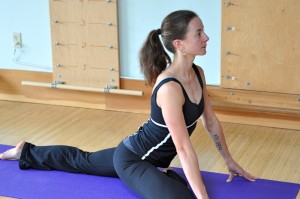
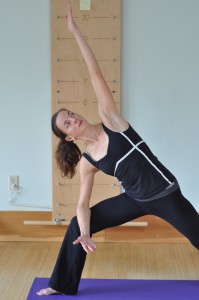
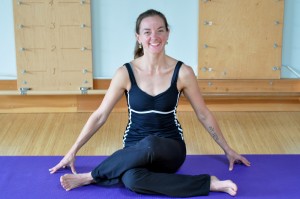
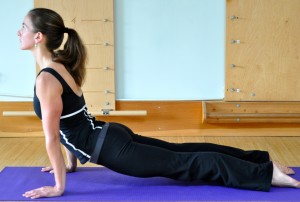
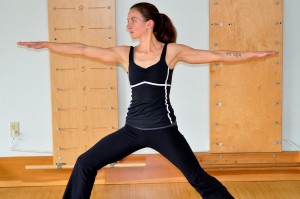
I’ve been taking Bikram Yoga classes (in a room heated to 105 degrees) for the past 3 months and agree that yoga is a very good complement to running (especially ultra distances). Caitlin is awesome, isn’t she? Hopefully, my wife won’t go into labor while she’s running in New York! Since she is our doula…
Great post and intro to this other way to run more sustainably, thanks for posting, Sarah, and sharing these tips, Caitlin!
One more thing on my bucket list… 😉
Thanks for the inside scoop on those classes (that I never would have been able to make). Yoga is always a good thing for us runners.
I have yet to actually incorporate yoga actively into my routine, but every time I’ve been to class I’ve enjoyed it, more for the mental state I attain than how my body feels.
Thanks for a great article!
Yoga is on the top of my list for this year now i’ve decreased the uktra KM’s. Thanks for this post….very inspirational and interesting too!
P.
Fanstastic information, thanks Sarah! I knew Caitlin was a kick-ass runner but didn’t realize she also taught yoga!
It seems that even the tightest runners could benefit greatly from the lengthening and strengthening benefits of yoga.
Trail running + yoga = balanced fitness!
Cheers, Elinor
Run Wild Retreats
in Italy, too we are doing a great job! Carlo P just did Boston in 2:46 and he practices a lot. I am Iyengar certified and that’s how I can run 20 hrs through Ultra Trail Mont Blanc! Namasté